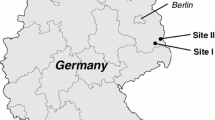Abstract
The beneficial effects of shelterbelts and windbreaks have been convincingly demonstrated in the temperate regions of the world. Investigations conducted on the biological effects of windbreaks are relatively few in arid and semiarid zones. In the semiarid regions of Haryana under Social Forestry programmes large scale plantations along roads, canals, fields, etc. were undertaken. In this region, an area having a windbreak of Dalbergia sissoo (18 years old) was selected and cotton was raised in the agricultural fields. The tree belt is able to reduce the windspeed by 15 to 45% depending upon season and wind speed. Observations on morphological characters and crop yield revealed that the belt height had a significant effect on plant growth. In general growth and cotton productivity increased upto distance of four times the tree height to the leeward of belt. Depending upon the orientation of tree belt, an increase in cotton yield was found to be 4 to 10%. Plant growth (in terms of leaf area, leaf number, plant height) and yield (seed cotton production) were observed to be high in sheltered area as compared to open fields. The results indicate that windbreak establishment should be adopted and integrated to a whole farming system, in semiarid regions.
Similar content being viewed by others
References
Caborn JM (1965) Shelterbelts and windbreaks. Faber and Faber, London
Champion HG and Seth SK (1963) A revised survey of the forest types of India. Ministry of Agriculture Govt. of India, Delhi, 404 pp
Davis RM (1976) Great plains windbreaks. History and an overview. Great Plains Agricultural Council Publication No. 76: 8–11
El-Sayed AB (1969) Effect of windbreak on some agricultural crops. MSc Thesis, Alexandria University, 173 pp
Grachev A (1957) Shelterbelts: Kamyshin in Stalingrad. Stalingrad Publishing House (English Translation for N. Sc. Found, Washington DC)
Hagen LJ (1976) Windbreak design for optimum wind erosion control. In: Tinus RW, ed, Shelterbelts on the Great Plains. Agricultural Publication 78: 31–36
Home JM (1949) Shelterwood or belts, Leaflet No. 5. Department of Agriculture, Scotland
Hussein MF (1969) Effect of windbreaks and shelterbelts. Agric Res Rev 47(2): 81–89
International Development Research Centre (1985) Report Manuscript on Seminar International on Shelterbelt in Tunis, Tunisia. IDRC-MR 117 e,f
Khalil AEE (1982) Influence of windbreaks on field and forage crops in West Nubariah region. MSc. Thesis, Alexandria University, Alexandria, 127 pp
Khalique A and Sheikh MI (1985) Windbreak studies in Pakistan. In: Report Manuscript on Seminar International on Shelterbelt in Tunis, Tunisia, pp 130–148. IDRC-MR 117 e, f
Khosla PK and Puri S (1986) Agroforestry systems — a new challenge. Indian Society of Tree Scientists Publication, Solan, India
Labaznikov BV (1982) Geographical variation in the protein content of grain crops in fields protected by shelterbelts. Lesnoe Khoazyaistvo No. 8: 30–32. Cited from Forestry Abstracts (1983) 44: FA 6786
Naegeli W (1957) Report to the Govt. of Israel on shelterbelts and windbreaks. FAO Report No. 586 (FAO/57/1/246), 27 pp
Puri S and Bangarwa KS (1991) Effect of trees on the yield of wheat crop in semiarid regions. Agroforestry Systems (Communicated)
Puri S and Monga BD (1990) Use of Prosopis in the farming system of arid regions of Haryana. National Seminar on Agroforestry, Its Present Status and Scope for Future Development in Farming Systems, pp 51–57, Oct. 9–11, N. D. Univ. Agric. Tech., Faizabad, India
Puri S, Kaur A and Singh S (1990) Role of windbreaks and shelterbelts in enhancing productivity. New World Environment Series, Ashish Publishing House, New Delhi
Rehman S (1978) Effect of shelterbelts on the yield of wheat crop in Mastung valley (Balochistan). Pak J For 28: 4–6
Rosenberg NJ (1975) Windbreaks and shelter effects. Progress in Biometeorology, Nebraska 1: 108–134
Sheikh MI (1988) Planting and establishment of windbreaks in arid areas. Agric Ecosyst Environ 22/23: 405–423
Sheikh MI and Khalique A (1982) Effect of tree belts on the yield of agricultural crops. Pak J For 31: 21–23
Skidmore EL (1976) Barrier-induced microclimate and its influence on growth and yield of winter wheat. In: Tinus RW, ed, Shelterbelts on the Great Plains. Great Plains Agricultural Publication 78: 57–63
Steel RGD and Torrie JH (1980) Principles and Procedures of Statistics (2nd Edition) McGraw-Hill, Inc, New York
Stoeckler JH (1950) Shelterbelts in Italy. Foreign Agriculture 14(9): 196–198
Author information
Authors and Affiliations
Rights and permissions
About this article
Cite this article
Puri, S., Singh, S. & Khara, A. Effect of windbreak on the yield of cotton crop in semiarid regions of Haryana. Agroforest Syst 18, 183–195 (1992). https://doi.org/10.1007/BF00123316
Issue Date:
DOI: https://doi.org/10.1007/BF00123316




